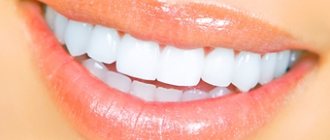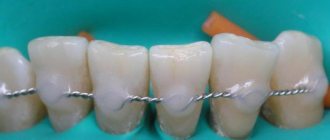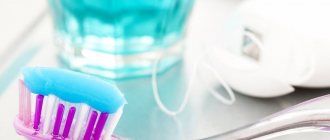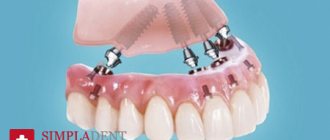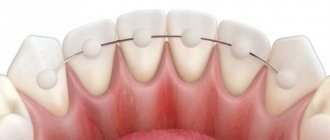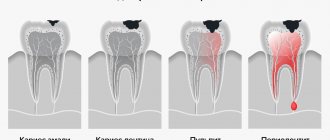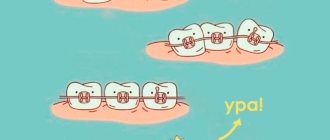Author of the article:
Soldatova Lyudmila Nikolaevna
Candidate of Medical Sciences, Professor of the Department of Clinical Dentistry of the St. Petersburg Medical and Social Institute, Chief Physician of the Alfa-Dent Dental Clinic, St. Petersburg
Weak and loose gums are a problem that many people face today. As a rule, the appearance of this defect is preceded by inflammatory periodontal diseases, such as gingivitis and periodontitis. Patients with such diseases suffer from a number of unpleasant symptoms:
- Severe redness, swelling of the gums;
- Bleeding while eating or brushing teeth;
- Tooth mobility;
- The formation of “pockets” - spaces between the tooth and gum, in which food debris, bacterial mass, and, in some cases, pus accumulate;
- Exposure of the cervical area of the teeth, and in severe cases, the roots.
- Strong, pungent odor from the mouth.
The listed symptoms are only the most harmless consequence of weakening gum tissue. In the absence of proper treatment, it threatens the loss of teeth, including healthy ones. That is why strengthening the gums and teeth is the primary task of the dentist and periodontist when treating patients with such problems. However, today it is also possible to strengthen gums at home. You will learn how to strengthen your gums and teeth yourself from our material.
Causes associated with dental diseases
The cause of loose teeth in the gums can be various dental diseases, such as periodontitis, periodontal disease, periodontitis and gingivitis. Incorrect bite can also trigger the appearance of this disease.
With gingivitis, many bacteria live in the oral cavity, which cause bleeding gums and, as a result, loosening of teeth.
With periodontitis, the same symptoms are present, but they are also accompanied by bad breath and inflammatory processes in the gums begin. The cause of both diseases is poor oral hygiene.
Periodontal disease is not associated with inflammatory processes and is accompanied by a decrease in the bone walls between all teeth, resulting in bleeding and itching in the gums, and the teeth become mobile and their sensitivity increases.
Causes of disease not related to gum disease
Dental disease is not the only factor that causes loose teeth. This process can occur for a number of other reasons:
- As a result of genetic predisposition to the disease.
- Weakening of the immune system.
- Diabetes.
- Hormonal imbalances.
- Psoriasis.
- Trauma to the maxillofacial area.
- Arthritis.
Only a dentist can correctly determine the cause of the disease. If the teeth are loosened as a result of a strong blow, the doctor sends the patient for an x-ray for a more detailed diagnosis, and then decides on subsequent treatment. If the cause is a chronic disease, the doctor will prescribe dental procedures or prescribe the appropriate medication to strengthen the gums.
Prevention
To prevent tooth mobility, you must maintain careful oral hygiene and use brushes and pastes recommended by your doctor. Don’t forget to floss, irrigate, and rinse your mouth after eating. Regular visits to the dentist (every 6 months) for a preventive examination and professional cleaning will help identify pathology at the initial stage, avoid complications, and maintain a healthy smile.
Author of the article Voznyuk Vladimir Aleksandrovich Maxillofacial surgeon-implantologist of the highest category
Work experience: 28 years.
Diet and vitamins
Proper, balanced nutrition is necessary for gum health. To strengthen the mucous membranes and blood vessels, you need to eat foods high in vitamin C, such as citrus fruits and green leafy vegetables. Vitamin K, found in large quantities in green vegetables and herbs, has a similar effect. Antioxidants and tannins contained in green tea and red wine have an anti-inflammatory and healing effect, slowing down the aging process. In addition, it is important to consume enough phosphorus, calcium and zinc - they are contained in seafood, garlic and onions, and dairy products.
Vitamin complexes are well suited as an additional source of nutrients - in particular, the vitamin-mineral complex for teeth ASEPTA. It contains vitamins A, B3 and B6, C, D3, as well as coral calcium and green tea extract. In addition, coenzyme Q10, which is contained in the complex, has a powerful regenerating effect and restores damaged gum tissue.
Content:
- Why is there a need to strengthen enamel?
- Signs in the presence of which you need to think about strengthening
- Products that can help improve the situation
- Dentist advice
- Strengthening techniques used in dentistry
- Pastes and gels
Tooth enamel is one of the hardest tissues of the human body.
But, despite its strength, over the years it gradually collapses and becomes thinner. Then a completely logical question arises: how to strengthen teeth in order to avoid serious dental problems. Violation of the natural structure of the enamel layers is facilitated by eating too hot and very cold foods, smoking, and a love of sweets. Oral health is also negatively affected by the fact that many people do not pay due attention to daily hygiene care. They ignore the need for an annual visit to the dental hygienist.
Folk remedies for treating illness
Regular rinsing of the mouth with special solutions or decoctions of medicinal plants is an excellent remedy for strengthening the gums. For this purpose, you can use decoctions of oak bark, eggplant peel, and horseradish. The most popular herbs for strengthening gums are chamomile, sage, St. John's wort, mint, and burdock.
Four folk recipes for rinsing to strengthen gums:
- Tea tree oil is an effective remedy for strengthening weak gums due to its ability to heal wounds and fight bacteria. To prepare a solution that needs to be used to rinse the mouth, take 2 drops of oil and half a glass of clean water.
- One of the popular folk recipes is a tincture made from a mixture of linden blossom and oak bark in equal proportions. To prepare it, just take a teaspoon of each component and pour 2 cups of boiling water over them. You should rinse your mouth with the resulting product after each meal.
- You can disinfect the oral cavity with cognac. To do this, you need to rinse it with a small amount of drink.
- Burdock decoction. The product should be used at least twice a day. To prepare it, you need to boil a tablespoon of the herb in 500 milliliters of water, then cool and strain through cheesecloth or a sieve.
To strengthen the gums and teeth, it is recommended to massage with the thumb and forefinger. The gums are treated with vertical massaging movements - from one tooth to another. Each section should be worked for 20 seconds. To increase efficiency, you can carry out the procedure by first dipping your fingers in honey or tea tree oil.
To strengthen the gums, it is recommended to use lotions:
- Plantain juice helps a lot. A cotton or gauze swab is moistened in it and applied to the gum.
- A decoction of young pine needles. To prepare the lotion, you need to boil 3 tablespoons of needles in 200 milliliters of water for 10 minutes. After this, the product is infused for at least 7 hours. A cotton swab dipped in the broth is applied to the sore gums.
Products that can help improve the situation
In the human body, a lot depends on nutrition. It is impossible to have a healthy smile if you consume a huge amount of junk food every day. If a person wants to make his enamel resistant to the negative influences of external irritants, he should eat a lot of fresh fruits and vegetables. Also useful:
- Seafood. They are a quality source of phosphorus.
- Fermented milk and dairy products containing calcium.
- Kiwi. This fruit is a real storehouse of ascorbic acid. At the same time, unlike oranges, tangerines and lemons rich in this vitamin, it does not irritate the enamel.
- Greenery. Source of a huge amount of vitamins and microelements. You definitely need to eat it. If a person does not like greens, they should treat them as natural medicine and still use them in their cooking on a regular basis.
- Honey. Beekeepers call it a natural antiseptic. It perfectly relieves inflammation and promotes rapid healing of gum disease.
To strengthen your teeth, it is very important to stop drinking any sweet carbonated drinks, smoking, and alcohol. It is also not recommended to frequently chew nuts and seeds or smoke.
Ointments and gels
The main advantage of gels and ointments compared to rinses is their ability to remain longer on the surface of the gum mucosa - and, as a result, provide a therapeutic effect for a longer time. ASEPTA healing gel contains propolis, a component of natural origin that has antibacterial, anti-inflammatory and regenerating effects. Thanks to this, the gel, when used regularly, can eliminate almost all the unpleasant symptoms that accompany weakening gums, as well as have a positive effect on the condition of the tissues themselves. The product is applied twice a day to the affected areas (necessarily after thorough brushing of the teeth). After using it, do not consume food or liquid for half an hour. This gel allows you to quickly strengthen your gums at home.
An equally effective remedy is the adhesive balm ASEPTA. The sticky pectin base prevents saliva from washing off the balm from the surface of the mucous membrane - its antimicrobial effect lasts more than half an hour. The balm contains powerful antiseptic components - chlorhexidine and metronidazole, which can prevent the development of inflammatory gum diseases - gingivitis and periodontitis.
Features of Cerec technology
Cerec root inserts and crowns are made from metal-free materials - it can be ceramic or zirconium dioxide. They can be installed even for allergy sufferers without fear. This technology has completely changed traditional approaches to dentistry.
Now the restoration process is comfortable and takes a minimum of time. In my clinic, the procedure is carried out in several stages.
I would also like to note that only one anesthesia is required and there are practically no errors when creating new teeth. Stages:
- An intraoral scanner determines the boundaries of the damage. This is especially important when only the roots of the front teeth or molars remain. The remaining tissues, antagonist teeth, and closed rows are scanned.
- The information is transferred to a computer, where all the images are combined into an image.
- The program creates a three-dimensional model of the remaining tooth, all defects are clearly visible. Then models of the inlay and crown are created that perfectly replicate the anatomical features of the tooth. Dimensions and shape are calculated accurately. It is determined what kind of restoration is needed.
- The design is made from blanks on a milling module. The elements are being tried on. In rare cases, correction is required. Shade discrepancies or other issues that displease the patient can be easily corrected within a few minutes.
- The completed root inlay fits hermetically to the remaining parts of the tooth, is securely fixed and exactly matches the shape.
Thus, it is possible to quickly restore units if only the roots of the teeth of the lower or upper jaw remain.
Toothpaste for strengthening gums
Therapeutic and prophylactic toothpastes are also an excellent tool for combating looseness of gingival tissue. Proper brushing of teeth is effective in itself - by massaging the gums with a brush, we improve blood circulation in the tissues and remove plaque, which is a constant source of infectious danger. In addition, many pastes contain antiseptic components that kill pathogens. However, it should be remembered that such pastes cannot be used for a long time, as this may negatively affect the state of the natural microflora of the teeth.
For regular use, pastes based on natural ingredients are better suited. For example, ASEPTA and ASEPTA Sensitive toothpastes contain extracts of calendula, sage, St. John's wort, sweet clover, calamus and other medicinal plants that relieve inflammation, eliminate bleeding and have a mild antiseptic effect. ASEPTA Sensitive paste also contains minerals - potassium citrate and hydroxyapatite, which increase the resistance of teeth to caries.
Degrees of mobility
- I
– the tooth deviates back and forth from neighboring units
by no more than 1 mm
, there are no symptoms from the periodontium or gums; - II
– amplitude of swing back and forth and sideways
by 1 mm or more
, tartar and plaques are visible on the enamel, redness, swelling, bleeding and soreness of the gums are possible; - III
– the teeth swing strongly in any direction with slight pressure with the tongue or chewing, the amplitude of the displacements
significantly exceeds 1 mm
; - IV
– the tooth shifts in all planes, rotates around its axis, and
barely stays
in the gum tissue.
Pathological mobility of any degree requires complex treatment. If the tooth is located in the gum, the periodontium and socket are intact, the process is reversible. Dental units begin to become very loose when periodontitis or periodontal disease is advanced. With deep periodontal damage, weakening and destruction of the ligamentous apparatus, bone atrophy, tooth extraction may be required, followed by implantation and prosthetics.
How to strengthen teeth and gums? Basic recommendations
List of recommendations for strengthening gums:
- Use special toothpastes.
- Introduce dairy products into your diet, as well as foods containing large amounts of vitamin D.
- Use rinse aids.
- Use floss to clean teeth in hard-to-reach areas.
- See your dentist regularly to check the condition of your teeth and gums.
See your dentist regularly to check the condition of your teeth and gums.
Examples when only the roots of the teeth in the upper jaw remain
Example 1. Restoration from one root of a front tooth
In this example (presented in full here), the situation was created literally by the patient’s hands. She tried to glue part of the tooth with superglue and, under the influence of dangerous substances contained in the glue, the crown of the tooth became completely unusable.
But the root of the tooth under the crown below remained intact and unharmed.
The length of the healthy part of this tooth root removed all doubts about the question - is it necessary to restore the root? Certainly! - it is possible and necessary. The tooth was restored in 1.5 hours using Cerec technology. And here in the photo is the happy owner of a new restored front tooth:
Example 2. Restoring 3 front teeth, of which only the roots remain
Here is a treatment example where I restored the aesthetics of her smile to a 22-year-old girl. The three front teeth on the upper jaw were completely destroyed. From the upper teeth 1.2, 1.1, 2.1 only
the roots
:
These three teeth were actually an aesthetically unsightly frame made from old fillings. Now we will not analyze the whole case in detail, I would like to draw your attention to the following points:
- the shape of the roots of the teeth and their condition made it possible to restore them
- There was no talk at all about any amputation - removal of the roots of the teeth of the upper jaw and implantation.
Our patient's smile was designed in a computer program:
So, in the photo below you see a general set for restoring our patient’s dentition, and among the modules there are 3 with a crown and a root.
The roots of the upper front teeth were quickly and, most importantly, effectively restored:
and our patient underwent a beautiful transformation and became the owner of a sweet and chic smile:
This is the enormous potential and aesthetic power of healthy tooth roots! Don't rush to delete them)
Example 3. Complete restoration of the smile zone on the front teeth of the upper jaw
This example is actually very popular on the Internet, since the patient is a TV presenter, and as a result of the treatment she found her new smile. Which is extremely important for her profession. I describe the detailed clinical case itself in another article, but here I would like to note the main points related specifically to the restoration of the roots of the front teeth with crowns.
In the picture below we have removed composite restorations and carious lesions. only the roots remain of the two front incisor teeth.
:
Crowns and “crown + root” modules were prepared in the laboratory:
After installation, the smile began to shine with bright colors:
You can see the entire chronology of our patient’s treatment in one large picture, step by step:
Consumer Reviews
Kotty about Asepta adhesive gum balm (otzovik.com)
“I had to purchase this adhesive balm because the dentist diagnosed me with periodontal disease. Therefore, when I have gum inflammation, I use this drug in courses every 6 months. I must note that the drug very quickly exerts its healing effect on the gums. The pain goes away immediately after starting treatment.
The dentist recommended that I lubricate my gums at night, once a day for 7 days.
Having studied the composition, I saw there such a substance as metronidazole and chlorhexidine. I realized that metronidazole is still an antibiotic. But since I was prescribed this medicine, I was calm. Although, frequent use of substances such as chlorhexidine and metronidazole on the skin and mucous membranes is undesirable, because the protective properties that the mucous membrane and skin should produce may cease to be produced. The dentist told me this too. Therefore, it is very important to use such products only for their intended purpose and strictly according to the instructions.
Of the indicated effects of the balm on the gums, the following were indicated:
- pronounced antibacterial effect on the gums;
- relieving inflammation and bleeding gums;
- breath freshening.
The package also contained a special plastic spatula, which was used to apply the balm to the gums. I must say that it is very comfortable. The balm itself is very thick and hardens after application. But the taste is generally tolerable.
I am satisfied with the effect of the balm. Good quality. It's not that expensive, considering that it lasts a long time. I recommend".
Minuto4ka about Asepta mouthwash (otzovik.com)
“Mint is an acquired taste, in everything. For example, I can completely tolerate it and love it. But I know a lot of people who can’t stand tongue-biting additives.
These are the first associations that arose for me when I first used this mouthwash.
It is sweet and has a lime flavor. And absolutely non-biting.
They prescribed it to me for absolutely no reason, of course.
My dentist prescribed it for me. For gums, which really bother me due to the periodic eruption of wisdom teeth. Which I'm terrified of deleting.
The rinse aid is sold in pharmacies, I haven’t seen it in supermarkets, which captivates me. I would like to believe that it is truly therapeutic in nature. They prescribed me this mouthwash along with Asepta dental gel. I don’t know which of them helped in the end. Maybe all together.
I think the advantage of the bottle is the presence of a measuring cup. It is very comfortable. Not all mouthwashes have it...
... overall I recommend it. At least it will win over its audience with its taste.”
Sources:
- Study of the clinical effectiveness of the use of therapeutic and prophylactic agents of the ASEPTA series in the treatment of inflammatory periodontal diseases in children and adolescents (I.V. Klimova) Irina Vladimirovna Klimova, Candidate of Medical Sciences, Associate Professor of the Department of Pediatric Dentistry, Novosibirsk State Medical University. Department of Pediatric Dentistry, Novosibirsk State Medical University.
- Clinical studies of antisensitive toothpaste “Asepta Sensitive” (A.A. Leontyev, O.V. Kalinina, S.B. Ulitovsky) A.A. LEONTIEV, dentist O.V. KALININA, dentist S.B. ULITOVSKY, Doctor of Medical Sciences, Prof. Department of Therapeutic Dentistry, St. Petersburg State Medical University named after. acad. I.P. Pavlova
- Report on clinical trials to determine/confirm the preventive properties of commercially produced personal oral hygiene products: mouth rinse "ASEPTA PARODONTAL" - Solution for irrigator." Doctor of Medical Sciences Professor, Honored Doctor of the Russian Federation, Head. Department of Preventive Dentistry S.B. Ulitovsky, doctor-researcher A.A. Leontiev First St. Petersburg State Medical University named after academician I.P. Pavlova, Department of Preventive Dentistry.
- The role of anti-inflammatory rinse in the treatment of periodontal diseases (L.Yu. Orekhova, A.A. Leontyev, S.B. Ulitovsky) L.Yu. OREKHOVA, Doctor of Medical Sciences, Prof., Head of Department; A.A. LEONTIEV, dentist; S.B. ULITOVSKY, Doctor of Medical Sciences, Prof. Department of Therapeutic Dentistry of St. Petersburg State Medical University named after. acad. I. P. Pavlova
Examples of canine restoration when only the root remains of the tooth
Example 4. The pin in the root of the lower tooth was removed, and the canine itself was restored
In this clinical case, I was restoring the lower canine, and the task was to save the root of the tooth and restore the coronal part of the canine, which was almost destroyed by caries. The anterior wall of the lower canine was made in the form of a filling, and it fell apart from the cutting edge.
As you can see in the photo, an anchor pin was installed inside the tooth - this is a pin that is screwed into the canal to strengthen the tooth. The tooth under the filling and the root of the lower canine were affected by caries. When the carious tissue was removed, only the root and a small part of the wall
:
You and I remember the main topic of our article, which tells us the following - if the tooth root remains, it can be completely restored. And this is not the first time that the unique Cerec technology has come to our aid. Using it and digital scanning, we restored the missing tooth module, which also included the root part:
Next, we restore the lower front tooth using a CEREC inlay and get an excellent result - the lower canine is completely restored:
Example 5. The root of the tooth under the crown of the upper canine has not rotted, and therefore the tooth is 100% restored
In this case, there was a total restoration of the dentition (veneers and crowns) with the replacement of worn-out crowns on the front teeth. One of the upper canines under the crown was seriously affected by caries, but its root was practically healthy - only a small part of the tooth root was damaged, see the following photo:
The missing “crown + root” module and new crowns were manufactured in a laboratory. In general, everything is in a smile, it looks just great:
And the owner of a new beautiful smile herself cannot hide her admiration:
All the main tasks in this total work were successfully solved, but the main thing you should pay attention to is that we managed to save the tooth root here too.

